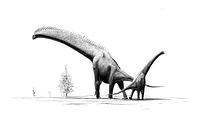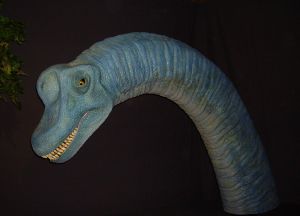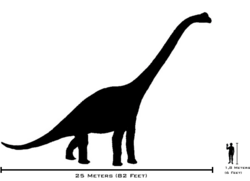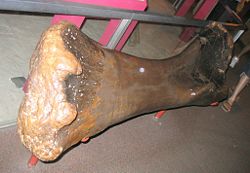Difference between revisions of "Brachiosaurus" - New World Encyclopedia
Rick Swarts (talk | contribs) (Added article from Wikipedia and credit and category tags) |
({{Contracted}}) |
||
| Line 1: | Line 1: | ||
| + | {{Contracted}} | ||
:''For the prehistoric amphibian see [[Branchiosaurus]]''. | :''For the prehistoric amphibian see [[Branchiosaurus]]''. | ||
{{Taxobox | {{Taxobox | ||
Revision as of 16:10, 3 May 2007
- For the prehistoric amphibian see Branchiosaurus.
| Brachiosaurus
| ||||||||||||||||||
|---|---|---|---|---|---|---|---|---|---|---|---|---|---|---|---|---|---|---|
 Brachiosaurus (Giraffatitan) brancai
| ||||||||||||||||||
|
Extinct (fossil)
| ||||||||||||||||||
| Scientific classification | ||||||||||||||||||
| ||||||||||||||||||
|
Brachiosaurus (IPA: /ˌbɹækiəˈsɔɹəs/) meaning "Arm Lizard", from the Greek brachion/βραχιων meaning 'arm' and sauros/σαυρος meaning 'lizard', was a genus of sauropod dinosaur which lived during the Late Jurassic Period. It was thus named because its forelimbs were longer than its hind limbs. One of the largest animals ever to walk the earth, it has become one of the most famous of all dinosaurs and is widely recognised worldwide.
For many decades, Brachiosaurus was the largest dinosaur known. It has since been discovered that a number of giant titanosaurians (Argentinosaurus, for example) surpassed Brachiosaurus in terms of sheer mass. More recently, another brachiosaurid, Sauroposeidon, has also been discovered; based on incomplete fossil evidence, it too is likely to have outweighed Brachiosaurus.
Brachiosaurus is often considered to be the largest dinosaur known from a relatively complete fossilized skeleton. However, the most complete specimens, including the Brachiosaurus in the Humboldt Museum of Berlin (excavated in Africa, the tallest mounted skeleton in the world), are members of the species B. brancai which some scientists consider to be part of a separate genus, Giraffatitan. The holotype material of the type species, B. altithorax. includes a sequence of seven posterior dorsal vertebrae, sacrum, proximal caudal vertebra, coracoid, humerus, femur and ribs: enough from which to estimate size.
Based on a complete composite skeleton, Brachiosaurus attained 25 metres (82 feet) in length and was probably able to raise its head about 13 metres (42 ft) above ground level. Fragmentary material from larger specimens indicates that it could grow 15% longer than this. Such material includes an isolated fibula HMN XV2 1340 cm in length and the brachiosaurid scapulocoracoid referred to Ultrasauros.
Brachiosaurus has been estimated to have weighed anywhere between 15 tonnes (Russell et al., 1980) and 78 tonnes.[1] These extreme estimates can be discarded as that of Russell et al. was based on limb-bone allometry rather than a body model, and that of Colbert on an outdated and overweight model. More recent estimates based on models reconstructed from osteology and inferred musculature are in the range 32 tonnes[2] to 37 tonnes (Christiansen 1997). The 15% longer specimens hinted at above would have massed 48 to 56 tonnes.
Discovery and species
The first Brachiosaurus was discovered in 1900 by Elmer S. Riggs, in the Grand River Canyon of western Colorado, in the United States.
Brachiosaurus species
Brachiosaurus includes three known species:
- B. alataiensis de Lapparent & Zbyszewski, 1957 has been referred to the new genus Lusotitan (Antunes and Mateus 2003). It is known from back bones (vertebrae), and parts of the hip and limbs, which were recovered in Estremadura, Portugal. It lived about 150 million years ago, during the Kimmeridgian age of the Late Jurassic period.
- B. altithorax Riggs, 1903: The type species is known from two partial skeletons recovered in Colorado and Utah in the United States. It lived from 145 to 150 million years ago, during the Kimmeridgian to Tithonian ages.
- ?B. nougaredi de Lapparent, 1960: While it may not be a distinct species (nomen dubium?) it is known from set of fused bones over the hip (sacrum) and parts of a forelimb, which were recovered in Wargla, Algeria in Africa. It lived 100 to 110 million years ago, during the Albian to Cenomanian ages of the middle Cretaceous period.
The best specimens of Brachiosaurus were from the species B. brancai, which was found in the Tendaguru Beds of Tanzania, in Africa in 1909 by Werner Janensch. In 1991, George Olshevsky placed them in a new genus, Giraffatitan, because they do not share the derived characteristics of Brachiosaurus. Giraffatitan has withers over its shoulder, and a rounded crest over its nostrils.
- Giraffatitan brancai Janensch, 1914 (formerly B. brancai): The new type species, it is known from five partial skeletons, including at least three skulls and some limb bones, which were recovered in Mtwara, Tanzania, in Africa. It lived from 145 to 150 million years ago, during the Kimmeridgian to Tithonian ages of the Late Jurassic period.
Description and environment
Brachiosaurus was a sauropod, one of a group of four-legged, plant-eating dinosaurs with long necks and tails and relatively small brains. Unlike other families of sauropods, it had a giraffe-like build, with long forelimbs and a very long neck. Brachiosaurus had spatulate teeth (resembling chisels), well-suited to its herbivorous diet. Its skull featured a number of holes, probably aiding weight-reduction. The first toe on its front foot and the first three toes on its hind feet were clawed.
Skull
Brachiosaurus has traditionally been characterised by its distinctive high-crested skull, but many scientists now assign the specimen which this depiction was based on to the genus Giraffatitan.
One complete Brachiosaurus skull is known. Marsh used it on his early reconstructions of Brontosaurus. Carpenter and Tidwell studied it in 1998 and found that it belonged to one of the North American Brachiosaurus species. The skull of Brachiosaurus is more camarasaur-like than the distinctive high-crested skull of Giraffatitan and it lends support to the opinion that Giraffatitan is a distinct genus.
Metabolism
Like other "long-necked" dinosaurs, Brachiosaurus may not have been able to pump sufficient oxygenated blood from its heart to its brain if it raised its head high above its shoulders, though this is disputed by some researchers [citation needed].
If the Brachiosaurus was endothermic (warm-blooded), it would have taken an estimated ten years to reach full size. If it were instead poikilothermic (cold-blooded), then it would have required over 100 years to reach full size. As a warm-blooded animal, the daily energy demands of Brachiosaurus would have been enormous; it would probably have needed to eat more than 400 lb. (~200 kg) of food per day. If Brachiosaurus was fully cold-blooded or was a passive bulk endotherm, it would have needed far less food to meet its daily energy needs. Scientists now believe that like most large dinosaurs, it was a gigantotherm.[citation needed]
Environment and behaviour

Brachiosaurus was one of the largest dinosaurs of the Jurassic era; it lived on prairies filled with ferns, bennettites and horsetails, and it moved through vast conifer forests and groves of cycads, seed ferns and ginkgos. Some of its contemporary genera included Stegosaurus, Dryosaurus, Apatosaurus and Diplodocus. While it is speculated that groups of Brachiosaurus moved in herds, fully grown individuals had little to fear from even the largest predators of the time, Allosaurus and Torvosaurus, on account of their sheer size.
Brachiosaurus nostrils, like the huge corresponding nasal openings in its skull, were long thought to be located on the top of the head. In past decades, scientists theorised that the animal used its nostrils like a snorkel, spending most of its time submerged in water in order to support its great mass. The current consensus view, however, is that Brachiosaurus was a fully terrestrial animal. Studies have demonstrated that water pressure would have prevented the animal from breathing effectively while submerged and that its feet were too narrow for efficient aquatic use. Furthermore, new studies by Larry Witmer (2001) show that, while the nasal openings in the skull were placed high above the eyes, the nostrils would still have been close to the tip of the snout (a study which also lends support to the idea that the tall "crests" of brachiosaurs supported some sort of fleshy resonating chamber).
Popular culture
Brachiosaurus is one of the most well-known dinosaurs amongst both paleontologists and the general public. As such, the genus has appeared in many films and television programmes, most notably Jurassic Park, Jurassic Park 3 and Walking with Dinosaurs. It also appeared briefly at the end of Walking With Monsters. A main belt asteroid, 1991 GX7, has been named 9954 Brachiosaurus in honor of the genus.[3][4]
Brachiosaurus has also made an appearance in several computer games, including Jurassic Park:Operation Genesis, Turok: Evolution and Jurassic Park: Rampage Edition for the SEGA consoles.
Berlin's G. brancai and Chicago's high flyer
A Brachiosaurus skeleton is mounted in the B Concourse of United Airlines' Terminal One in O'Hare International Airport in Chicago, courtesy of the Field Museum of Natural History of Chicago. It is a model, not a collection of fossils.
A famous specimen of Giraffatitan brancai mounted in Berlin, sometimes considered a species or sub-genus of Brachiosaurus, is one of the largest mounted skeletons in the world.
Beginning in 1909, Werner Janensch found many additional brachiosaur specimens in Tanzania, Africa, including some nearly complete skeletons, which were widely used in Brachiosaurus reconstructions. These are now considered to be Giraffatitan fossils.
Footnotes
- ↑ Colbert, 1962, table on p. 10. Exact figures given are 78.26 metric tons / 85.63 short tons.
- ↑ Paul, 1988
- ↑ JPL Small-Body Database Browser: 9954 Brachiosaurus (1991 GX7). NASA. Retrieved 2007-04-28.
- ↑ Williams, Gareth. Minor Planet Names: Alphabetical List. Smithsonian Astrophysical Observatory. Retrieved 2007-02-10.
ReferencesISBN links support NWE through referral fees
- Colbert, E. H. (1962). The Weights of Dinosaurs. American Museum Novitiates (2076): p. 1–16.
- Paul, G. S. (1988). The brachiosaur giants of the Morrison and Tendaguru with a description of a new subgenus, Giraffatitan, and a comparison of the world's largest dinosaurs. Hunteria 2 (3): 1–14.
- See entry on Brachiosaurus at DinoData (registration required, free)
- dB Brachiosaurus (Natural History Museum)
External links
- Expect awe-struck travelers, from the Field Museum. (O'Hare airport mount)
- Dinosaurier-Web, Description and printable fact-sheet with picture (in German and English)
| Dinosaurs Portal |
Credits
New World Encyclopedia writers and editors rewrote and completed the Wikipedia article in accordance with New World Encyclopedia standards. This article abides by terms of the Creative Commons CC-by-sa 3.0 License (CC-by-sa), which may be used and disseminated with proper attribution. Credit is due under the terms of this license that can reference both the New World Encyclopedia contributors and the selfless volunteer contributors of the Wikimedia Foundation. To cite this article click here for a list of acceptable citing formats.The history of earlier contributions by wikipedians is accessible to researchers here:
The history of this article since it was imported to New World Encyclopedia:
Note: Some restrictions may apply to use of individual images which are separately licensed.

